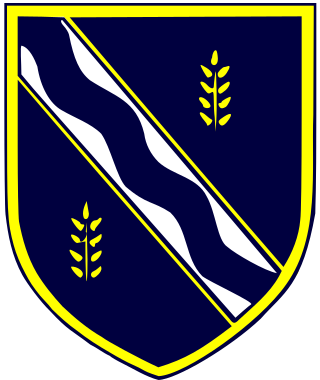Related Research Articles

The Blue Coat School is a co education Church of England academy for 11- to 18-year-olds, located in the town of Oldham, Greater Manchester, England.

Kennet School is an academy secondary school in Thatcham, Berkshire, England. In 2011, Kennet was the highest achieving state school in West Berkshire using contextual value added results and third-highest using five good GCSEs.
The King's Academy is an 11–19 secondary school and academy located in Coulby Newham in the Middlesbrough unitary authority, England, serving the community of South Middlesbrough. Established in 2003, it is run by the Emmanuel Schools Foundation established by entrepreneur Sir Peter Vardy. It was officially opened by Prime Minister Tony Blair in March 2004.
Amersham School is a mixed secondary school in Amersham, Buckinghamshire. In September 2011, the school became an Academy. It takes children from the age of 11 through to the age of 18 and has approximately 1020 pupils.

Landau Forte College Derby is an academy in Derby, England. As a secondary school and sixth form, it serves students aged 11–19 from the City of Derby and surrounding areas.
The Hundred of Hoo Academy is a 4–18 mixed, all-through school and sixth form with academy status in Hoo St Werburgh, Kent, England. It is part of the Leigh Academies Trust.
Oaklands Community School was a mixed comprehensive school in west Southampton, Hampshire, in the south of England. The school served the Lordshill community from 1983 to 2008 for 11 to 16-year-olds. In its later years during 2005 and 2008 it became a specialist Arts College.
Ellison Boulters Church of England Primary Academy is situated in Scothern, Lincolnshire, England, on Sudbrooke Road. It has around 270 pupils, and accepts them mainly from the village of Scothern and the neighbouring villages of Langworth and Sudbrooke. Pupils are accepted from some distance outside this three-village catchment area for which it was built, as a result of which a place at the school for local children is not guaranteed.

Burnage Academy for Boys, formerly known as Burnage High School for Boys, is an 11–16 boys secondary school with academy status, located in Burnage, Manchester, England. The school was founded in September 1932 as Burnage High School on its current site on Burnage Lane. At an ceremony on 21 October 1932, the school was officially opened by Sir Boyd Merriman.

Wey Valley Academy was a coeducational secondary school with academy status in Broadwey, Weymouth, in the county of Dorset, in southern England.

Harris Academy Purley is an academic secondary school in South Croydon, England. It is also part of the Harris Federation. Haling Manor High School was one of only fifteen schools in the country to be awarded specialist status as a music school.

Scalby School is a coeducational secondary school located in Scarborough, North Yorkshire, England. It caters for pupils aged 11–16, with around 980 on roll.

The Child Development Index (CDI) is an index combining performance measures specific to children—education, health and nutrition—to produce a score on a scale of 0 to 100. A zero score would be the best. The higher the score, the worse children are faring.

The Hans Price Academy, formerly known as Wyvern Community School, is a coeducational secondary school located on the Bournville estate in Weston-super-Mare, Somerset, England. The school had 743 students between the ages of 11 and 16 years as of 2013.
The income deprivation affecting children index (IDACI) is an index of deprivation used in the United Kingdom.
The English Baccalaureate (EBacc) is a school performance indicator in England linked to the General Certificate of Secondary Education (GCSE) results. It measures students' attainment by calculating an average score from specified subject grades. The EBacc includes subjects which are studied in many subsequent university programmes.
David Frederick St John Jesson is a British educationalist and a professor in the Department of Economics at the University of York, who studied specialist schools and value-added performance (CVA).

English state-funded schools, commonly known as state schools, provide education to pupils between the ages of 3 and 18 without charge. Approximately 93% of English schoolchildren attend such 24,000 schools. Since 2008 about 75% have attained "academy status", which essentially gives them a higher budget per pupil from the Department for Education.
Bideford College is a mixed secondary school and sixth form located in Bideford in the English county of Devon. The principal is Claire Ankers.
The Progress 8 benchmark is an accountability measure used by the government of the United Kingdom to measure the effectiveness of secondary schools in England. It bands pupils into groups based on their scores in English and mathematics during the Key Stage 2 SATs. In GCSE results, six EBacc subjects are chosen, in addition to English and Maths, and each grade is converted to points on an arbitrary scale published by the government for that cohort. English and mathematics are worth double points and all points are added together. This is also known as the Attainment 8 score.
References
- ↑ Leckie, George; Goldstein, Harvey (2017). "The evolution of school league tables in England 1992–2016: 'Contextual value-added', 'expected progress' and 'progress 8'". British Educational Research Journal. 43 (2): 193–212. doi: 10.1002/berj.3264 . hdl: 1983/1e21e0be-1bac-43de-b4cc-199116090de3 . S2CID 53868817.
- 1 2 3 Guide to 2008 secondary tables, BBC News, 2009-01-20, retrieved 2009-09-05
- ↑ The Key Stage 1 to 2 CVA measure, Department for Children, Schools and Families, archived from the original on 2009-09-17, retrieved 2009-09-05
- 1 2 Key Stage 2 to Key Stage 4 (KS2-KS4) Contextual Value Added Measure (CVA), Department for Children, Schools and Families, archived from the original on 2009-04-15, retrieved 2009-09-05
- ↑ Key Stage 4 to Key Stage 5 Contextual Value Added Measure, Department for Children, Schools and Families, archived from the original on 2009-04-14, retrieved 2009-09-05
- ↑ Contextual value added characteristics, Department for Children, Schools and Families, archived from the original on 2009-08-17, retrieved 2009-09-05
- ↑ Technical Annex: How is a contextual value added score for a pupil calculated, DCSF, archived from the original on 2007-11-10, retrieved 2009-10-22
- ↑ PUBLICATION OF 2009 TEST AND EXAMINATION RESULTS IN THE SCHOOL AND COLLEGE ACHIEVEMENT AND ATTAINMENT TABLES (PDF), DCSF, 2009-10-15, archived from the original (PDF) on 2009-08-23, retrieved 2009-10-15
- ↑ Concerns over pupil progress data, BBC News, 2006-06-25, retrieved 2006-09-05